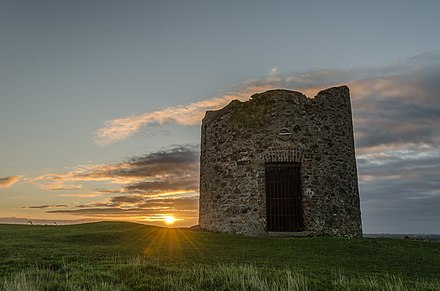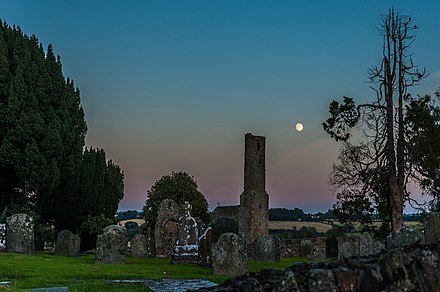County Wexford - county in Ireland
County Wexford (Irish: Contae Loch Garman) is in Southeast Ireland, and historically part of the province of Leinster. Its coast is lined by long sandy beaches and by caravan parks. Inland is a rich heritage, especially of medieval times and of the rebellion of 1798.
Towns
- Wexford 📍 the county town was founded as a Viking port.
- Rosslare 📍 is a seaside resort and ferry port.
- Enniscorthy 📍 was a centre of the 1798 rebellion.
- Ferns 📍 is a tiny village that was once capital of Leinster. It has a cluster of medieval ruins.
- Gorey 📍 is a small market town; its main attraction is the beach resort of Courtown.
- New Ross 📍 is near the JFK arboretum and family homestead.
- Fethard-on-Sea 📍 is near Tintern Abbey.
- Kilmore Quay 📍 is a fishing village on the south coast, with boat trips to Great Saltee Island.
Other destinations
- Mount Leinster 📍 at 793 m / 2605 ft is the highest of the Blackstairs Mountains, which form the boundary to the west with County Carlow - see Enniscorthy for walking routes.
- Great Saltee 📍 is the largest of the little islands around the coast, and the only one routinely visited by boat trips.
Understand
County Wexford forms the southeast corner of Ireland, where the coast turns from the Irish Sea to face the Atlantic. It's low-lying and fertile, less boggy than elsewhere, so it was settled from early times: there are many remnants of the Neolithic and Bronze Ages. Long stretches of sandy beach, which nowadays draw the day-trippers and the caravan parks, for earlier arrivals meant you could land a small boat almost anywhere. So it was well-connected to the rest of Ireland and to England: in the 5th century it was one of the first areas to become Christian. Wexford and Carlow comprised the Gaelic kingdom of Uí Ceinnselaig (Kinsella) who at times ruled all of Leinster, with their capital at Ferns. From the 8th century the Vikings raided then settled around Wexford town, and the first Norman beachhead in 1169 was near Fethard-on-Sea. The Normans laid out the present pattern of counties or shires in Ireland, and this was entrenched under the Tudors.
This led to a colonial era where a few incomers enjoyed wealth and political power at the expense of the native majority. A major uprising in 1641 established an independent Irish Confederation, smashed by Cromwell in 1652. County Wexford had only minor involvement in the Williamite Wars of the 17th / 18th century, but it was central to the 1798 rebellion of United Irishmen. This became known as "The Year of the French", though the French incursion was only a brief coda when the main rebellion was already crushed. But of all the lurid events of that year, the aspect seared into establishment minds was that of the French (who'd beheaded their own king and aristocracy) marching unchecked for 11 days across County Mayo, with a raggle-taggle band of Irish rebels flocking to join them.
The Society of United Irishmen sought to bring together Catholics and Protestants, and to free and reform Ireland along the lines of republican France and the United States. They tried but soon despaired of constitutional methods of reform. Outright rebellion broke out in May 1798, but its centre in Dublin collapsed at the outset, and it was soon quelled in other counties. Its main success was in County Wexford - by the end of May the rebels held the entire county and proclaimed a revolutionary republic. Now it only remained to liberate the rest of Ireland. On 5 June 1798 they assaulted New Ross and captured it for a few hours, then were driven back with great slaughter. On 9 June they attacked Arklow but were repulsed by gunfire. They retreated to Wexford as government troops converged upon them. Their last stand was on Vinegar Hill in Enniscorthy on 21 June. Even then, many escaped through a gap in the surrounding forces, but thereafter they could only mount pinprick attacks, and inexorably they were hunted down.
 The long-promised French support only arrived in Aug 1798, landing in County Mayo. It had unexpected success, brushing aside opposition, but 12 days later was encircled. The French surrendered while their Irish comrades were cut down by British bayonets. A last French landing attempt was at Lough Swilly in Donegal in October, but it was trounced by the Royal Navy, and the rebel leader Wolfe Tone was captured. Perhaps some 10,000 died in the course of the rebellion, and with them died the vision of United Irishmen. Future resistance to Britain, and interpretation of the events of 1798, was along sectarian lines, developing the fault line that would eventually sunder Ireland.
The long-promised French support only arrived in Aug 1798, landing in County Mayo. It had unexpected success, brushing aside opposition, but 12 days later was encircled. The French surrendered while their Irish comrades were cut down by British bayonets. A last French landing attempt was at Lough Swilly in Donegal in October, but it was trounced by the Royal Navy, and the rebel leader Wolfe Tone was captured. Perhaps some 10,000 died in the course of the rebellion, and with them died the vision of United Irishmen. Future resistance to Britain, and interpretation of the events of 1798, was along sectarian lines, developing the fault line that would eventually sunder Ireland.
Get in
Five trains a day run from Dublin Connolly via Dún Laoghaire, Bray, Wicklow Town, Rathdrum and Arklow to Gorey, Enniscorthy, Wexford, Rosslare Strand and Rosslare Europort the ferry terminal. The line between Rosslare and Waterford was axed in 2010.
Rosslare Europort has daily ferries from Pembroke and Fishguard in Wales, taking about four hours. In summer there are also ferries from Cherbourg, Roscoff and Bilbao, but these didn't sail in 2020.
There's competition on the bus route from Dublin: Expressway and Wexford Bus both run hourly from Dublin Airport and city centre via Arklow to Gorey, Enniscorthy and Wexford.
A cross-country bus runs from Rosslare Europort to Wexford, New Ross, Waterford, Cork, Killarney and Tralee.
By road from Dublin follow N11 / M11 along the coast.
Get around
Train is the best option for anywhere along the Dublin-Europort line, with stops at Rosslare Strand, Wexford, Enniscorthy and Gorey.
Bus is a good option for anywhere along the route from Dublin (eg to Ferns, which doesn't have trains) or the cross-country route to Waterford (eg to New Ross). Beyond that is a sparse service of rural and Local Link buses. You need your own wheels to get around the many outlying places, especially on Hook Peninsula. The county is low-lying and the distances aren't great, so cycling is an option.
See

- John F Kennedy Arboretum south of New Ross commemorates JFK, and the nearby homestead was the Kennedy ancestral home.
- The Famine Ship in New Ross is a replica of a sailing ship that carried many away to North America.
- Ferns medieval ruins include a castle, cathedral and abbey.
- The Irish National Heritage Park is at Ferrycarrig 3 km west of Wexford.
- Johnston Castle has a lavish interior, gardens and the Irish Agricultural Museum. It's 5 km south of Wexford.
- The museum of the 1798 rebellion is in Enniscorthy where the rebels made their last stand.
- Tintern Abbey near Fethard-on-Sea was staffed by Cistercian monks from the better-known Tintern Abbey in Monmouthshire.
- Hook Head is the scenic peninsula below Fethard.
- Islands lie off the coast, while others (eg Bannow) have become fused to the mainland. Boat trips from Kilmore Quay visit Great Saltee, a nature reserve.
Do

- Beaches: the best are at Courtown near Gorey, Curracloe near Wexford, several near Rosslare (Strand, St Helens Bay and Carne), and Duncannon to the west with Booley Bay and Doller Bay.
- Go to the races: Wexford Racecourse 2 km west of town centre has jumps racing. Enniscorthy has greyhound racing two evenings a week.
- Watch Gaelic games: county GAA teams play Gaelic football and hurling in Wexford. There are almost 50 club sides across the county.
- The Wicklow Way is a 131 km walking trail from Dublin to Clonegal on the boundary with County Carlow. The southern sections of the trail are lowland and pastoral, yet feel more away-from-it-all than the touristy mountain sections further north near the city.
Eat
- Strawberries are a county specialty, ripening earlier here.
- Wexford has the widest selection of cuisine. La Côte has excellent seafood, but there's also Schnitzel Haus, a Ramen outlet, Thai and South Indian.
- The Duck, within Marlfield House in Gorey, is probably the county's top restaurant.
- Bar and hotel food may be your best bet anywhere elsewhere. The beach resorts have the usual cheap and cheerful offerings.
Drink

- In Wexford, two long-time favourites are Thomas Moore Tavern and The Sky And The Ground.
- In Enniscorthy, try Holohan's and Antique Tavern.
- In New Ross, sup in the historic Tholsel.
- There are two breweries in Wexford and one in Courtown near Gorey. There's no whiskey distillery in the county, but gin is produced near Enniscorthy.
Stay safe
- As it's lowland, natural hazards are few, but safety on water always needs care.
- Mind the traffic, and don't leave valuables on display in parked cars.
Go next
- County Carlow is rolling pasture, stud farms, and (in a land where the bar is set high) one helluva bog.
- County Kilkenny is picture-perfect rural Ireland, centred on the marble city of Kilkenny.
- County Waterford has Viking, medieval and Georgian heritage in Waterford city, and castles and mansions aplenty.
- County Wicklow is a ridge of mountains with cascading waterfalls, the monastic complex of Glendalough, and great mansions and gardens on the outskirts of Dublin.
County Wexford
wexford.ieLeinster
Primary administrative division